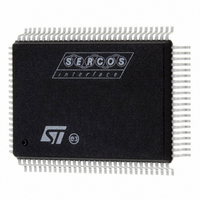ST92F150CV1QB STMicroelectronics, ST92F150CV1QB Datasheet - Page 294

ST92F150CV1QB
Manufacturer Part Number
ST92F150CV1QB
Description
MCU 8BIT 128K FLASH 100PQFP
Manufacturer
STMicroelectronics
Series
ST9r
Datasheet
1.ST92F150CV1TB.pdf
(429 pages)
Specifications of ST92F150CV1QB
Core Processor
ST9
Core Size
8/16-Bit
Speed
24MHz
Connectivity
CAN, I²C, LIN, SCI, SPI
Peripherals
DMA, LVD, POR, PWM, WDT
Number Of I /o
77
Program Memory Size
128KB (128K x 8)
Program Memory Type
FLASH
Eeprom Size
1K x 8
Ram Size
4K x 8
Voltage - Supply (vcc/vdd)
4.5 V ~ 5.5 V
Data Converters
A/D 16x10b
Oscillator Type
Internal
Operating Temperature
-40°C ~ 105°C
Package / Case
100-QFP
Processor Series
ST92F15x
Core
ST9
Data Bus Width
8 bit, 16 bit
Data Ram Size
6 KB
Interface Type
CAN, I2C, SCI, SPI
Maximum Clock Frequency
24 MHz
Number Of Programmable I/os
80
Number Of Timers
5 x 16 bit
Operating Supply Voltage
4.5 V to 5.5 V
Maximum Operating Temperature
+ 105 C
Mounting Style
SMD/SMT
Development Tools By Supplier
ST92F150-EPB
Minimum Operating Temperature
- 40 C
On-chip Adc
16 bit x 10 bit
Lead Free Status / RoHS Status
Lead free / RoHS Compliant
Other names
497-4882
Available stocks
Company
Part Number
Manufacturer
Quantity
Price
Company:
Part Number:
ST92F150CV1QB
Manufacturer:
STMicroelectronics
Quantity:
10 000
- Current page: 294 of 429
- Download datasheet (8Mb)
J1850 Byte Level Protocol Decoder (JBLPD)
J1850 BYTE LEVEL PROTOCOL DECODER (Cont’d)
Received Message Filtering
The FREG[0:31] registers can be considered an
array of 256 bits (the FREG[0].0 bit is bit 0 of the
array and the FREG[31].7 bit is bit 255). The I.D.
byte of a message frame is used as a pointer to
the array (See
Upon the start of a frame, the first data byte re-
ceived after the SOF symbol determines the I.D. of
the message frame. This I.D. byte addresses the
I.D. byte flags stored in registers FREG[0:31]. This
operation is accomplished before the transfer of
the I.D. byte into the RXDATA register and before
the RDRF bit is set.
If the corresponding bit in the message filter array,
FREG[0:31], is set to zero (0), then the I.D. byte is
not transferred to the RXDATA register and the
RDRF bit is not set. Also, the remainder of the
message frame is ignored until reception of an
EOFmin symbol. A received EOFmin symbol ter-
minates the operation of the message filter and
enables the receiver for the next message. None
of the flags related to the receiver, other than
IDLE, are set. The EODM flag does not get set
during a filtered frame. No error flags other than
RBRK can get set.
If the corresponding bit in the message filter array,
FREG[0:31], is set to a one (1), then the I.D. byte
is transferred to the RXDATA register and the
RDRF is set. Also, the remainder of the message
is received unless sleep mode is invoked by the
Figure 137. I.D. Byte and Message Filter Array use
294/429
9
Figure
137).
value = n
I.D. byte
user program. All receiver flags and interrupts
function normally.
Note that a break symbol received during a filtered
out message will still be received. Note also that
the filter comparison occurs after reception of the
first byte. So, any receive errors that occur before
the message filter comparison (i.e. IBD, IFD) will
be active at least until the filter comparison.
Transmitted Message Filtering
When transmitting a message, the corresponding
FREG[0:31] I.D. filter bit may be set or cleared. If
set, then the JBLPD will receive all data informa-
tion transferred during the frame, unless sleep
mode is invoked. Everything the JBLPD transmits
will be reflected in the RXDATA register.
Because the JBLPD has invalid bit detect (IBD),
invalid frame detect (IFD), transmitter lost arbitra-
tion (TRA), and Cyclic Redundancy Check Error
(CRCE) it is not necessary for the transmitter to lis-
ten to the bytes that it is transmitting. The user
may wish to filter out the transmitted messages
from the receiver. This can reduce interrupt bur-
den. When a transmitted I.D. byte is filtered by the
receiver section of the block, then RDRF, RDOF,
EODM flags are inhibited and no RXDATA trans-
fers occur. The other flags associated normally
with receiving - RBRK, CRCE, IFD, and IBD - are
not inhibited, and they can be used to ascertain
the condition of the message transmit.
Bit 1 = FREG[0].1
Bit 2 = FREG[0].2
Bit 3 = FREG[0].3
Bit n
Bit n+1
Bit 4 = FREG[0].4
Bit n-1
Bit 254 = FREG[31].6
Bit 255 = FREG[31].7
Bit 0 = FREG[0].0
Related parts for ST92F150CV1QB
Image
Part Number
Description
Manufacturer
Datasheet
Request
R

Part Number:
Description:
BOARD PROGRAM FOR ST92F150 MCU
Manufacturer:
STMicroelectronics
Datasheet:

Part Number:
Description:
BOARD EVALUATION FOR ST9 SERIES
Manufacturer:
STMicroelectronics
Datasheet:

Part Number:
Description:
BOARD EMULATOR FOR ST9 SERIES
Manufacturer:
STMicroelectronics
Datasheet:

Part Number:
Description:
MCU, MPU & DSP Development Tools ST9 Dedication Board
Manufacturer:
STMicroelectronics
Datasheet:

Part Number:
Description:
STMicroelectronics [RIPPLE-CARRY BINARY COUNTER/DIVIDERS]
Manufacturer:
STMicroelectronics
Datasheet:

Part Number:
Description:
STMicroelectronics [LIQUID-CRYSTAL DISPLAY DRIVERS]
Manufacturer:
STMicroelectronics
Datasheet:

Part Number:
Description:
BOARD EVAL FOR MEMS SENSORS
Manufacturer:
STMicroelectronics
Datasheet:

Part Number:
Description:
NPN TRANSISTOR POWER MODULE
Manufacturer:
STMicroelectronics
Datasheet:

Part Number:
Description:
TURBOSWITCH ULTRA-FAST HIGH VOLTAGE DIODE
Manufacturer:
STMicroelectronics
Datasheet:

Part Number:
Description:
Manufacturer:
STMicroelectronics
Datasheet:

Part Number:
Description:
DIODE / SCR MODULE
Manufacturer:
STMicroelectronics
Datasheet:

Part Number:
Description:
DIODE / SCR MODULE
Manufacturer:
STMicroelectronics
Datasheet:











